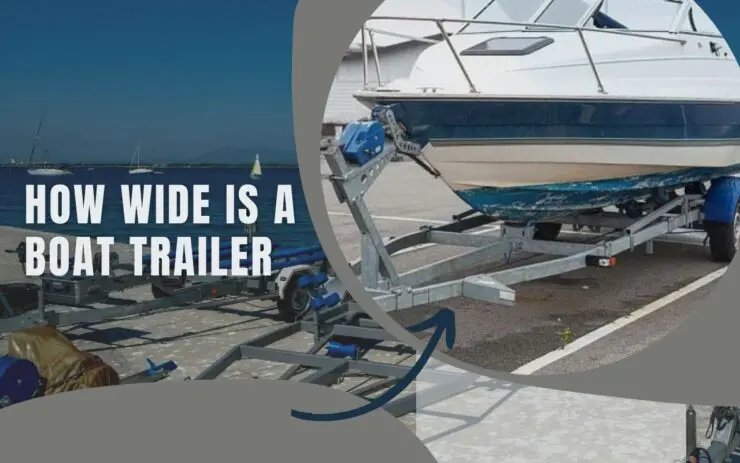Thinking about a boat trailer and confused with the measurements and right width? Well, you can make the measurement right all by yourself.
By now, you must know every state has different rules for boat trailers.
So, how wide is a boat trailer?
Since every state has its own rule for trailers, you must know the measurements accordingly. A boat below 8.5 feet required no permission.
On the other hand, 8.5 feet require special permission. However, your will vary depending on the length of your boat.
Interested to know more about it? We have a dedicated table to let you know what is the perfect trailer width for different boats.
So let’s jump right into the detailed discussion.
Table of Contents
ToggleWhat is A Boat Trailer?
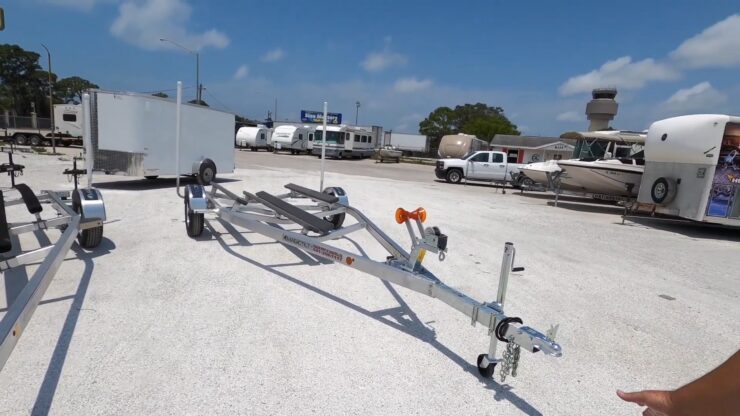
A boat designed intending to ride on the road is called a boat trailer. It is a must to be aware of the regulations and measurements of a boat trailer properly.
The use of trailered boats on highways required a set of regulations. Which needs to be followed set by the state.
So you should be aware of the rules of the other states as well. What if you have to move with your trailer to some other state. And that includes the ideal measurement of the trailer as well.
How to Measure Your Boat Trailer?
You have to be aware of the state’s rules as well as the required measurements according to your boat trailer. So how you would measure the length and width of your boat?
Let us know in detail right away.
- Measuring tape works great for getting the exact measurement of your boat. To measure the trailer length, follow the centerline of the trailer.
Put the tape at the front centerline and follow it till the end of the trailer centerline. If the length is enough for your boat, you are good to go.
- If the measurement is smaller than your boat, then it might hit your car. Now check for the outside of the width of the trailer.
For that, you can go from one side rail to the other rail.
- Next, you have to measure the front of the trailer which is the upper part of the trailer. The measurement would determine how further the trailer will go down.
- Weight should be a major concern about the trailer. Make sure you measure it when it is wet. The weight should include the fuel, engine, and equipment of the boat.
Following the mentioned steps, you can easily measure the boat trailer and get the measurement right.
Boat Trailer Standard Width
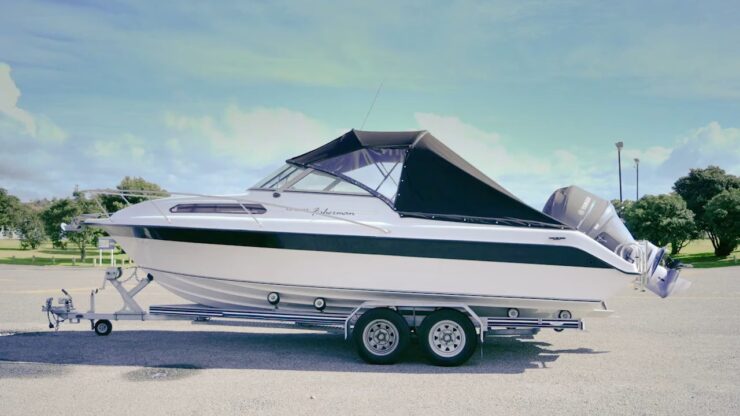
If you ask me what is that one thing you cannot compromise about a trailer is the measurement. You have to maintain an ideal size of the trailer according to the boat length.
We are providing a size chart of the boat trailer for a single axle bunk and tandem axle bank.
| Type of Boat | Boat Length | Overall Width |
| 14 – 15 feet | 5.17 feet | |
| Single Axle Bunk | 17 – 18.5 ft | 7 feet |
| 20 – 21 feet | 8.5 feet | |
| 18 – 20 feet | 8.5 feet | |
| Tandem Axle Bank | 21 – 23 feet | 8.5 feet |
| 25 – 27 feet | 8.5 feet |
Get the help from the chart to determine the preferred width for your boat. We have tried to cover the smallest size of the boat to the highest. And also provided the overall width accordingly.
You can purchase your necessary tools from the following suggestion box.
These are one of the best products available on the market. You can go for them without any hesitation.
Types Of Boat Trailers
Boat trailers come in a variety of types and sizes to fit different boats and towing needs. Here are some of the most common types of boat trailers:
Bunk trailers
These trailers have a set of bunks, or padded supports, that cradle the hull of the boat. They are commonly used for boats with V-shaped hulls and are usually easy to load and unload.
Roller trailers
Roller trailers have sets of rollers that support the boat’s hull, making it easier to launch and retrieve the boat. They are commonly used for boats with flat or shallow V-shaped hulls.
Pontoon trailers
These trailers are specifically designed to carry pontoon boats, which have two or more pontoons that provide buoyancy.
They typically have a set of bunks or cradles that support the pontoons and allow the boat to be loaded and unloaded easily.
Drive-on trailers
These trailers have a flat surface that the boat is driven onto, rather than being lifted on by a crane or winch. They are commonly used for smaller boats and are easy to load and unload.
Skiff trailers
They are designed to carry lightweight, flat-bottomed boats. They typically have a flat bed with a set of bunks or rollers that support the boat’s hull.
Catamaran trailers
Catamaran trailers are designed to carry catamarans, which are boats with two parallel hulls. They typically have sets of bunks or cradles that support the hulls and allow the boat to be loaded and unloaded easily.
When choosing a boat trailer, it’s important to consider the size and weight of your boat, as well as your towing capacity and any local regulations regarding trailer size and weight. With the right trailer, you can safely and easily transport your boat to and from the water.
Boat Trailer Material
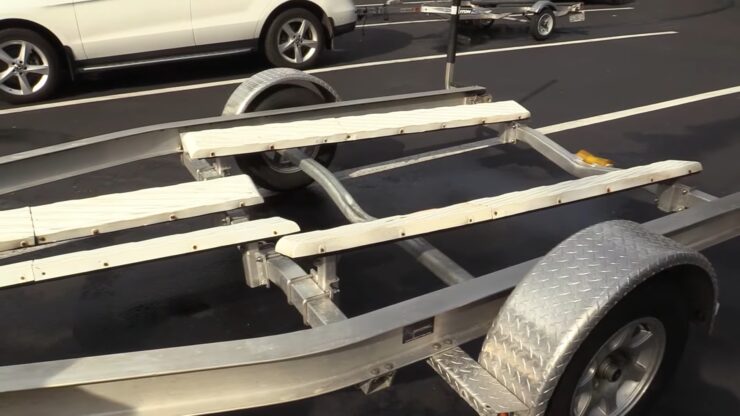
You can also make preferences according to the material of a trailer. Choosing the right one is very important just like at the time of replacing the floorboard. There are a few options available for you. Let us discuss the most familiar ones.
Steel
Steel is one of the most popular materials used for boat trailers due to its strength and durability. It can handle heavy loads and rough terrain, making it a great choice for long-distance transportation. Additionally, steel trailers are often more affordable than other materials.
However, steel is susceptible to rust and corrosion, which can weaken the trailer over time. Regular maintenance and rust prevention treatments can help to extend the life of a steel boat trailer.
Aluminum
Aluminum is a familiar material for its lightweight and adaptive capacity in different regions. It might not trouble you with rust but it is prone to corrosion.
However, it is economic to fuel use due to its lightweight. It is also more appealing to the consumers compared to other materials.
Galvanizer Steel
Galvanizer steel prevents corrosion well but it is unable to protect from rust. However, it can protect the light wiring setup inside the wiring tube and also the brake line.
Another fact about galvanized steel is that it is quite heavier than other available materials. So it can carry the load better.
Axles And Spring
Boat trailers use a combination of axles and springs to support the weight of the boat and trailer and provide a smooth ride while towing. Here’s a closer look at how these components work:
Axles
Boat trailer axles are usually made of steel and come in a variety of sizes and weight capacities. The size of the axle will depend on the weight of the boat and trailer, and the number of axles will depend on the size of the trailer.
Tandem axle trailers, for example, have two axles that provide more stability and weight distribution than single axle trailers.
Springs
Boat trailer springs are designed to absorb shock and vibration while towing, providing a smoother ride for the boat and trailer.
They come in a variety of types, including leaf springs, coil springs, and torsion springs.
Leaf springs are the most common type of spring used on boat trailers and consist of several layers of spring steel stacked together.
They are durable and provide good support for heavier loads.
The combination of axles and springs on a boat trailer plays a critical role in the trailer’s performance and safety.
It’s important to ensure that the trailer is properly equipped with the correct axles and springs for the weight of the boat and trailer, and that they are in good working order before towing.
Regular maintenance, including greasing the axles and inspecting the springs for wear or damage, can help prevent issues while on the road.
Additionally, knowing how to properly load the boat and trailer can help distribute the weight evenly and reduce stress on the axles and springs, prolonging the life of the trailer.
FAQs
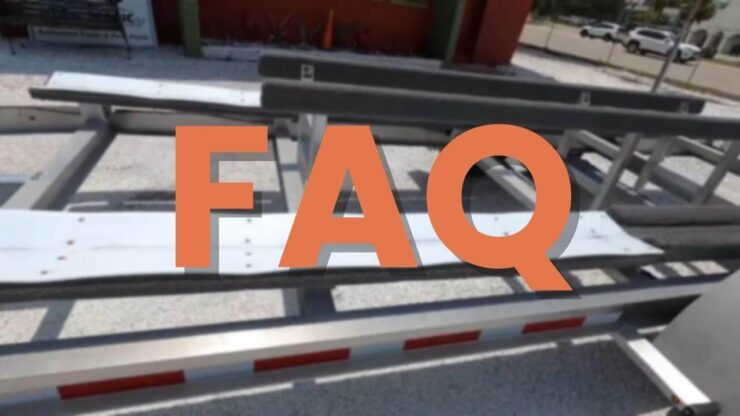
How wide is a boat usually?
Commonly a regular boat size is around 18-20 feet long. But if we talk about cats, it would be 22-30 feet wide. So the boat slip rental size is determined by the beam of the boat.
You must need to measure the dock. It will let you know that your boat is wide enough to be safe from bang.
How wide should be a boat slip?
An ideal boat slip should be around 60 inches wide. A boat that has a linear pier edge of around 10 feet should have at least 60 inches of opening.
However, it is very important to take the measurements seriously regarding boats. That’s how you can avoid any issues while moving to other states.
How a boat should fit in the trailer?
While setting a boat trailer, make sure there is 2 inches gap between the tongue plate cover and keel. The nd of the roller should align with the transom and the bow eye should touch the winch post. And that’s how a proper trailer should fit in.
Final Word
We hope we could provide every detail regarding how wide trailer is? If you are still confused about it, ask for the expert’s help.
And one final tip for you, make sure your boat trailer is getting proper maintenance. Otherwise, it might get damaged even before the desired lifespan.
I’m Liam Jackson, the proud owner and driving force behind KayakPaddling.net. Born somewhere in the expansive beauty of the United States, I’ve nurtured a lifelong passion for kayaking and fishing that has led me to explore the far corners of our nation’s waterways.
Related Posts:
- 16 Best Kayak For Beginners 2024 - Kayaking Adventure Gear
- 12 Best Beach Wagons & Carts 2024 - For All-Terrain
- 20 Best Inshore Spinning Reels 2024 - Capturing All…
- 10 Best Fish Finders Under $200 2024 - Top Affordable Picks
- Livingston Boat Modifications: Things You Can Add
- Heavy Duty Fishing: 11 Best Rods And Reels For Big Fish 2024

